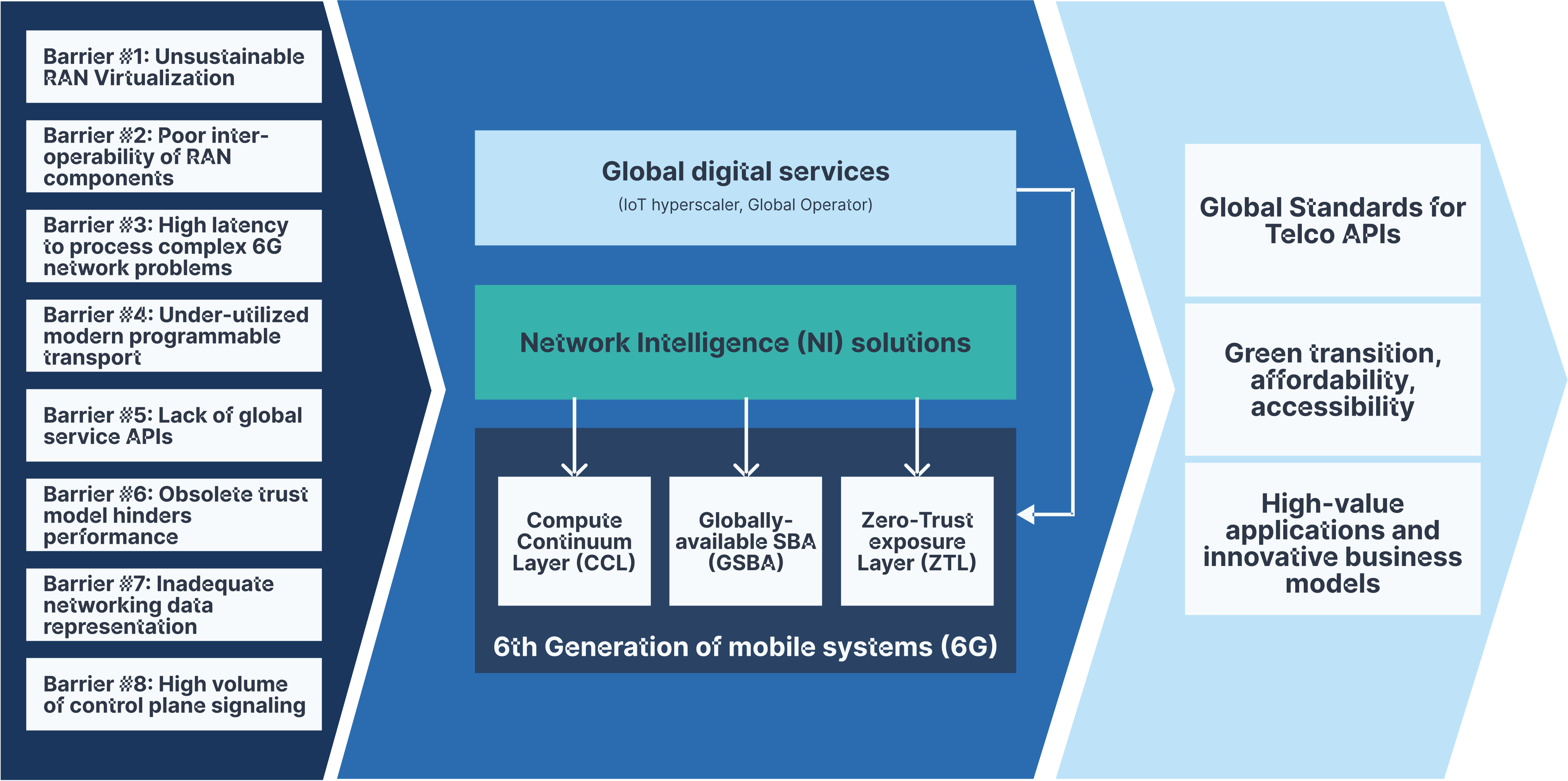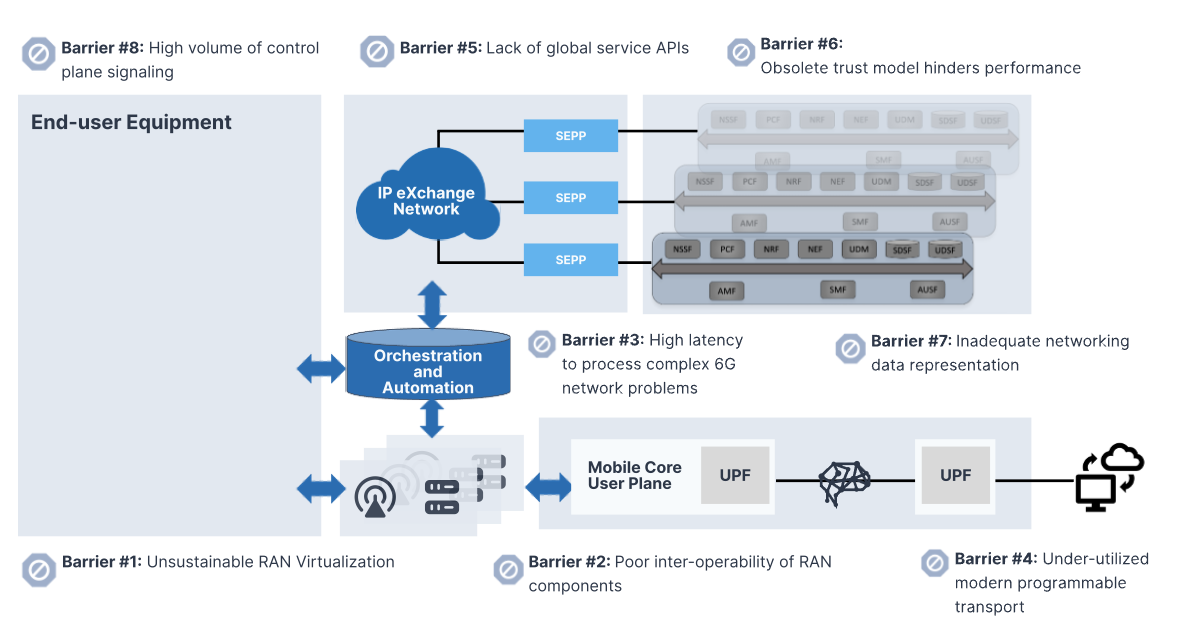Objectives

The main goal of ORIGAMI is to develop a novel cross-plane architecture for 6G networks that supports original exposure and compute layers, which jointly (a) remove practical barriers towards 6G, (b) enable sustainable, energy- efficient, and affordable 6G systems, and (c) promote new and disruptive 6G business models.
ORIGAMI aims at achieving this goal by designing:
- a Global Service-Based Architecture model that fosters inter-operability across data, control, management, orchestration and NI planes,
- a Zero-Trust exposure Layer that supports unprecedented levels of network customization driven by verticals that include other MNOs, and
- a Compute Continuum Layer that unlocks streamlined control over virtualized functions at very fast timescales.
On top of such architectural innovations, ORIGAMI will develop novel, tangible, verifiable, and measurable NI solutions and digital services that will allow demonstrating the viability of its vision in realistic use cases.
The main goal above is decomposed into specific, practical and measurable objectives along three dimensions, as follows.
Objective 1
The first objective is evolving the architecture of current mobile systems to meet highly demanding KPIs concerning affordability, sustainability, flexibility, and performance expected for 6G. ORIGAMI aims at contributing to the design of a 6G architecture for mobile systems that extends the 5G Service-Based Architecture (SBA) model by integrating multiple planes, boosts efficiency for next-gen computing, and promotes new business models.
The first objective of ORIGAMI is centered around three key pillars:
- Enhancing Interconnectivity across planes: We aim to establish seamless connections between multiple planes, such as management and orchestration, O-RAN/3GPP user and control planes, and Network Intelligence. To achieve this, we will expand the existing SBA approach of 3GPP by developing a GSBA, which will enable effective deployment of network intelligence across various domains and planes.
- Leveraging AI and abstractions: ORIGAMI will build abstractions and harness the power of AI to efficiently multiplex highly heterogeneous computing resources with performance guarantees. This will create a continuous spectrum of computing capacity, brokered by a Compute Continuum Layer (CCL) to support the growing complexity of next-generation tasks while ensuring cost-effectiveness and energy efficiency.
- Developing a novel exposure layer: ORIGAMI will design an innovative exposure layer, referred to as Zero-Trust exposure Layer (ZTL), that empowers third parties and virtual operators to customize their networks on top of shared infrastructure well beyond today’s network slicing technologies. More specifically, ORIGAMI’s approach shall eliminate the need for trust or central coordination, as required today by 5G, offering unprecedented flexibility and autonomy in network management.
Objective 2
The second objective is designing and developing NI functionalities that enable energy and cost-efficient use of radio, networking, and computing resources. We have identified a concrete list of 8 barriers in current mobile systems that prevent efficient use of these resources. For the above objective, ORIGAMI’s goal is to design intelligent algorithms that exploit the aforementioned CCL and the GSBA architectural innovations to address these barriers across different network domains (fronthaul, RAN, backhaul).
Specifically, NI instances will be devised for different network domains:
- Design and develop infrastructure-aware virtualized RAN functions. ORIGAMI will demonstrate how compute-aware virtualized RAN solutions can build reliable RAN systems that improve cost and energy-efficiency compared to today’s industry standards, that are based on dedicated hardware acceleration. ORIGAMI aims at creating affordable and sustainable mobile systems. To achieve this, we need to identify new ways of using low-cost green resources while keeping high-quality performance and reliability.
- Improve the inter-operability among open RAN components. An inter-operable inter-dependable ecosystem is essential for the effective deployment of 6G RAN functions. To this end, ORIGAMI will address challenges in AI design, testing, and deployment, to perform management and control between RIC platforms and network functions in a more agile manner and providing robustness upon anomaly behavior.
- Exploit novel compute paradigms to solve complex network processing problems with low latency. ORIGAMI will tackle novel problems arisen from novel 6G technologies by investigating asynchronous functions, binarized neural networks, scalable learning algorithms and quantum computing to optimize performance without compromising User Plane efficiency.
- Design and build models and tools to exploit in-band computing capabilities in transport (backhaul, midhaul, fronthaul) and core domains. ORIGAMI aims to harness programmable user planes for 6G applications by overcoming current limitations with innovative solutions in ultra-low latency metadata collection, in-band data processing, real-time scheduling, and uncertain decision-making policies for ML libraries.
Objective 3
The third objective is designing and developing NI functionalities and global APIs that enable global deployment of services (e.g., IoT hyperscalers) with multi-domain performance guarantees. ORIGAMI aims to tackle the inherent lack of trust within the cellular ecosystem that hinders the exploitation of telco resources globally by (still) relying on procedures from a bygone era. We aim to define and implement ORIGAMI’s Zero-Trust exposure Layer (ZTL) to enable the “exposure” of resources within the ecosystem, fostering a Global Service-Based Architecture for next generation networks, and unlocking new streams of revenue and business models.
More precisely, the ORIGAMI architecture aims to enable novel business models, and a dynamic approach for charging and billing:
- Decouple authentication and billing from connectivity. ORIGAMI aims at enabling zero- trust interactions between global service providers and the underlying infrastructure providers.
- Ensure reliable global operations. ORIGAMI aims at developing solutions that are based on new global data exposure and representation, and enable service monitoring and root-cause detection in globally operated networks, so as to guarantee performance for tenants building services on resources from many providers.
- Realizing a global service mesh. ORIGAMI will harness the potential of Global Service- Base Architecture through an approach relying on service mesh implementation. This will provide a cloud native implementation of the Service Communication Proxy (SCP) functionality and will also facilitate the development of Network Intelligence (NI) functionality for the network core.
Ultimately, achieving such objectives will allow producing solutions that remove eight practical barriers that are blocking progress towards effective 6G systems:
- Unsustainable RAN virtualization. Ineffective deployment and utilization strategies of computing resources at the radio access, as RAN virtualization solutions today rely on expensive and energy-consuming dedicated hardware accelerators.
- Poor inter-operability of RAN components. Lack of inter-operability between open RAN components and effective deployment of the RAN bus to enable multi-time scale controllability.
- High latency and unreliable NI to process complex 6G network problems. We need to solve complex 6G user-plane (UP) processing operations and control-plane (CP) optimization problems with low-latency and robust Network Intelligence (NI).
- Under-utilized modern programmable transport. Lack of models and tools to transparently exploit the in-band computing capabilities of modern programmable transport domains for the deployment of 6G VNFs into the user plane.
- Lack of global service APIs. Lack of infrastructure exposure and standardized APIs that go beyond silo-style optimization and can enable global service and monitoring, to support demands by global 6G devices.
- Obsolete trust model hinders performance. Current trust model hinders performance and growth. Scaling coverage requires pre-established agreements between the end-user and the cellular provider.
- Inadequate networking data representation. Lack of global data provisioning and representation makes service monitoring and root-cause detection challenging.
- High volume of control plane signaling. The rapid growth of control plane signaling, and the monolithic implementation of the NFs reduce scaling and resilience capabilities for the network core.


